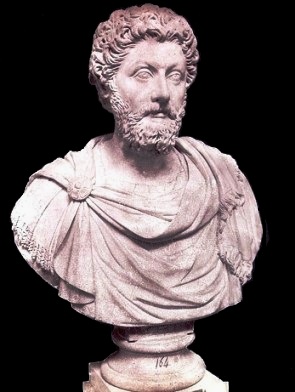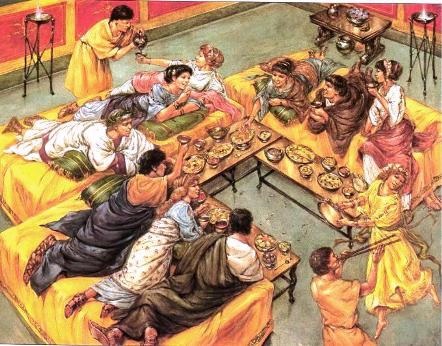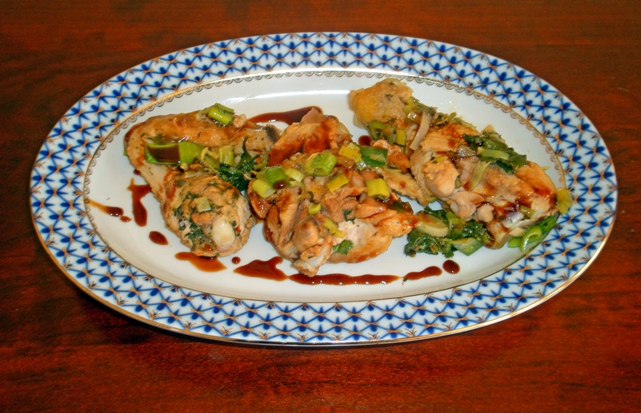
The recipe for Pullus Frontonianus (recipe 12, section IX of book 6), reads: “Stiffen [that is, brown], the chicken, add a mixture of liquamen and oil into which you put a bundle of dill, leek, savory and green coriander, and cook. When it is done, take it out, put it on a serving dish, sprinkle generously with defrutum and serve.”
I was puzzled by a few things here. I would have added at least some oil to the pan before searing the chicken, and I got no clear idea how much liquamen to add. I understand that garum and the liquamen called for by the recipe were not identical, but Laura’s garum is much more flavorful than the Southeast Asian fish sauces I’ve used. When making this recipe in the past, I have used three tablespoons of nam pla, but here I thought one tablespoon would make the dish just about as fishy as I could possibly want. So I browned the chicken in the oil and added the liquamen afterward, and I also covered the pan while the chicken cooked to prevent burning. In fact, I also added a tablespoon of water, which had the effect of deglazing the pan.

The resulting dish had a fairly strong fish aroma, but I also thought the effect of the garum similar to that of the chicken or veal stock a modern European chef might add to a sauté. The herbs provided a piquant counterpoint, and the defrutum gave the dish an oddly archaic flavor.
As for the name, in their edition of Apicius, Barbara Flower and Elizabeth Rosenbaum suggested that the Fronto in question was an obscure author of agricultural writings. This seems rather unlikely to me, since there was a much more famous Fronto to hand: the great orator Marcus Cornelius Fronto, whom the Romans considered second only to Cicero.
He was deadly serious about rhetoric, which, as the vehicle of great public issues, was self-evidently the only subject in the universe that truly mattered. When his pupil, the future emperor Marcus Aurelius, started studying philosophy, Fronto sent him a scolding letter: “You seem to me to have, in the fashion of the young, deserted the pursuit of eloquence and to have turned aside to philosophy, in which there is no introductory section to be elaborated and no account of the facts, bringing them together with concision, clarity and skill.”
Philosophy is a trivial pursuit, he informed young Marcus (who is of course mostly remembered today for his philosophical meditations). After a philosophical discussion, Fronto pointed out, you “go away carefree, with nothing to think over, or to write up at night, nothing to recite to your master, nothing to say by heart, no search for words, no adorning of a single synonym, no translation from Greek into our language.” Well, gosh, when you put it that way . . .
_______
Pullus Frontonianus
Prepared by Charles Perry
Ingredients
1 (4 ½-pound) chicken
4 tablespoons olive oil
1 tablespoon garum
1 leek, cleaned and sliced crosswise
5-6 sprigs dill, minced
2-3 sprigs fresh savory, minced
4-5 sprigs green coriander, minced
4-6 tablespoons defrutum or dibs ‘inab
Freshly ground pepper
Directions
Cut chicken into joints and pat dry. Put the oil in a pan and heat until quite hot, then add the chicken pieces without crowding the pan, and fry, turning often, until browned. Do in several batches if necessary.
Reduce the heat, add the garum, leek, dill, savory and green coriander, cover tightly and simmer until tender, about 20 minutes. Check around 15 minutes to make sure the liquid has not all boiled away.
To serve, arrange on a dish and sprinkle with defrutum and pepper to taste. Serves 3-4.
________
The original recipe from my version of Apicius (translated by Joseph Dommers Vehling) reads:
A HALF-COOKED CHICKEN MARINADED IN A PICKLE OF BROTH, MIXED WITH OIL, TO WHICH IS ADDED A BUNCH OF DILL, LEEKS, SATURY AND GREEN CORIANDER. FINISH IT IN THIS BROTH. WHEN DONE, TAKE THE CHICKEN OUT DRESS IT NICELY ON A DISH, POUR OVER THE REDUCED MUST, SPRINKLE WITH PEPPER AND SERVE.
You can see that Charles was faithful to the original recipe without much adaptation, so for those of you who think that most historical dishes are difficult to prepare, this is one to sink your teeth into. There is also a suckling pig à la Fronto, which I have prepared using pork tenderloin and it is also delicious.
As to Fronto, as Charles points out he was a famous orator who was important enough to scold a future Roman Emperor about his studies. But he was also a wealthy citizen who after coming to Rome during the reign of Hadrian amassed a large fortune, erected magnificent buildings and purchased the famous Gardens of Maecenas with its terraces and libraries near the Palatine Hill.

So, he is another famous person from the past exploited for advertising the cookbook named after Apicius. As a wealthy man, Fronto undoubtedly held lavish dinners and banquets and using his name on a couple of dishes in a book written several centuries later helped gain audience and increase interest. Sort of like someone today calling a dish William Jennings Bryan Chicken or Lamb à la Lincoln without historical sources to verify the links.
In regards to the garum, there are three observations that Charles makes that I find interesting, 1.) Garum is much more flavorful than the nam pla he usually uses to prepare the dish, and 2.) There was a strong fish aroma to the dish, but not a strong fish flavor, and 3.) The effect of the garum was to make the dish richer and add depth, sort of like the addition of lamb or veal stock by a modern chef might be.
I do have one interpretation that differs from Charles, and with respect, I’d like to discuss it a bit here. I think that there are no instructions for making defrutum in the Apician recipe, because it is just something that most Roman kitchens made in bulk and would have on hand. Defrutum and must of other juices and wines was a fairly common ingredient in many Roman dishes. If you don’t have access to a Persian or Mediterranean market of any flavor, you can make your own defrutum fairly easily. It is easy, but time consuming. Simply heat juice or wine to a near boil and then reduce to a low flame and cook gently until reduced to a syrup – stirring occasionally. One simply has to be careful not to burn or scorch to juice, or this flavor will carry through to the syrup or molasses. This is best done when working with 100 percent unsweetened juice or wine, and you need a lot of juice to make a small amount of syrup. For example, one large bottle of unsweetened pomegranate juice makes about 1/3 cup of pomegranate syrup. It keeps for a long time once refrigerated.
Well, thanks for Charles for his fantastic kickoff to our Ancient Roman cookoff! A great meal to be enjoyed anytime or for a bit of extra authenticity, crack a volume of Graves or watch I Claudius reruns while cooking and preparing the table.
I am eagerly looking forward to the dishes and presentations by the other participants as well, including a Roman patina by Sally Grainger. With Easter coming up, I am cooking a leg-of-lamb marinated in yogurt and spices Saudi style and a rice dish for tomorrow. Then I am on the road to Kashgar and other places in NW China for a couple of weeks. I will cook my entry for the cookoff when I return. (Words and recipe by Charles Perry; fore-and after matter by Laura Kelley. Photo of Charles Perry borrowed from LA Weekly Blogs; Photo of Pullus Frontonianus by Charles Perry)

